
art of travel
What’s New
The Latest Product Updates from India
Compiled by Soma Paul, Product Manager, Destination Knowledge Centre
STAYS TO WATCH OUT FOR
New Hotels
We Are Excited About
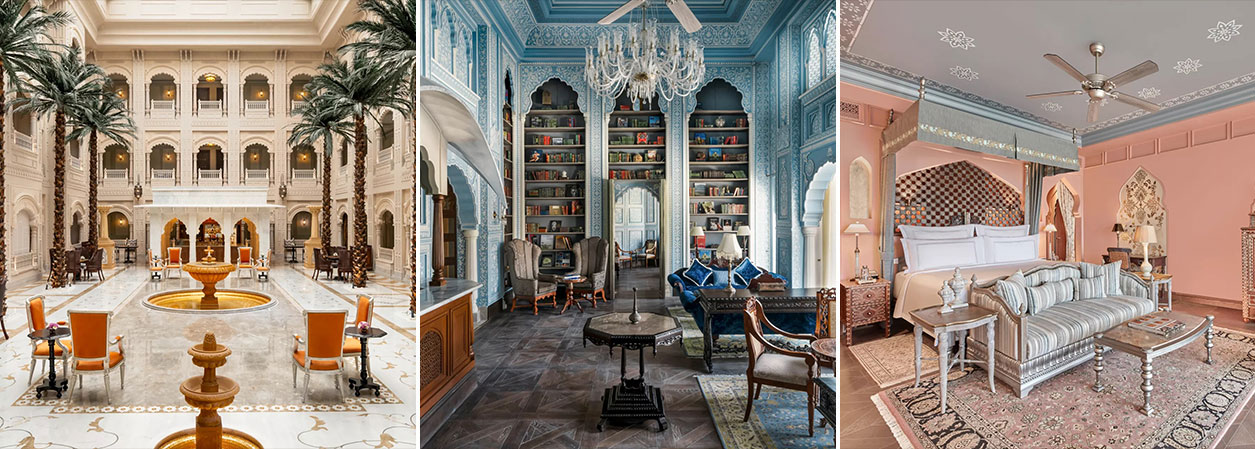
Raffles Jaipur, Rajasthan
Raffles Hotels & Resorts has expanded its footprint in India by launching its second property in Rajasthan. The 50-key Raffles Jaipur is a reimagined palace retreat, hand-carved from white marble, located in the Kukas Village. Every room is unique in design and decor, with spacious balconies and luxurious modern comforts. The food is a mix of traditional Indian and international cuisine. For guests seeking rejuvenation and relaxation, the spa features indulgent treatment rooms, mineral pools, a state-of-the-art fitness studio and a rooftop pool with a spectacular city view.

Gajlaxmi Palace, Dhenkanal, Odisha
Gajlaxmi Palace is nestled amidst nature with stunning views of the mighty Megha hill adorned with sal, teak, bamboo, and two water bodies. Your hosts are Kumar Saheb Jitendra Pratap Singh Deo and his wife Kumarani Navneeta Singh Deo from the royal family of Dhenkanal. While J.P. accompanies guests for nature walks and safaris, Navneeta’s exceptional culinary skills elevate the experience with delicious home-cooked meals. Having been in operation for a while, Gajlaxmi Palace is relatively lesser-known and worth discovering. The property is home to a diverse array of birdlife, making it a notable destination for birdwatchers. Also, guests may explore nearby tribal and weaver villages during their stay. The heritage homestay is conveniently located about a 2-hour drive from Bhubaneswar Airport.
Write to your relationship manager for more details
EXPERIENCES TO WATCH OUT FOR
New Experiences
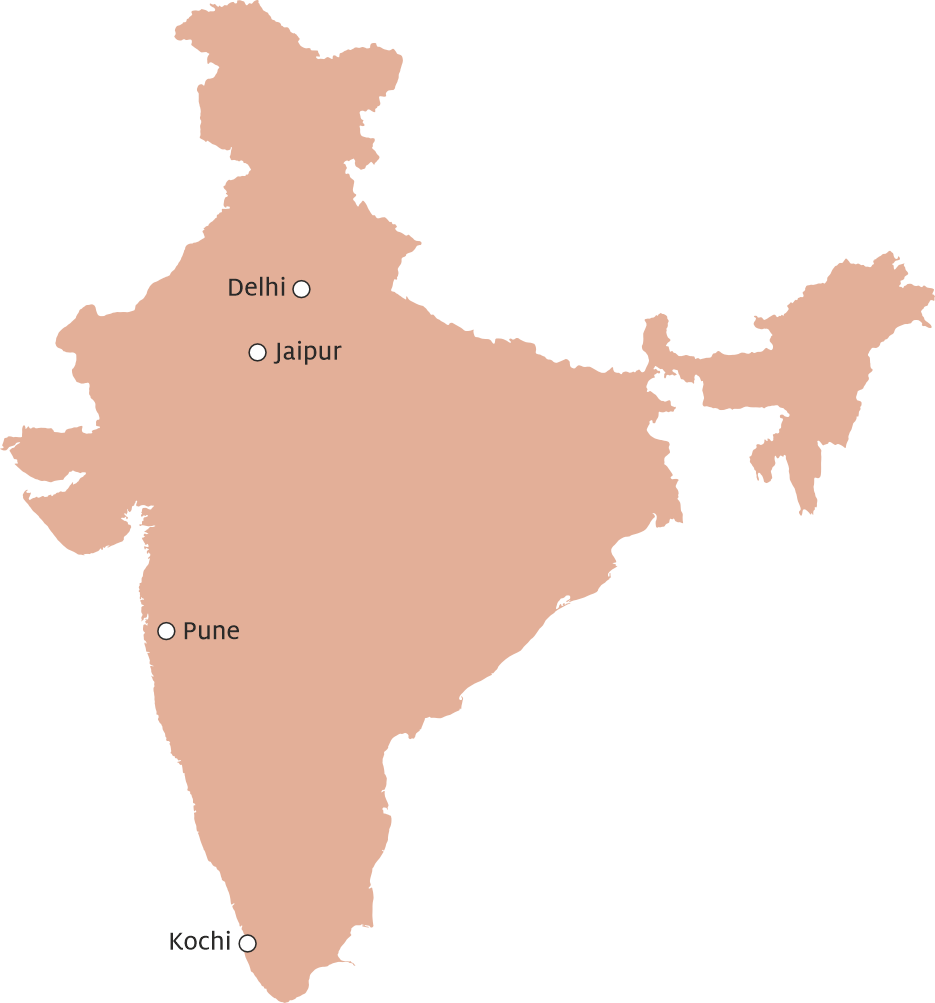
- Stories, secret recipes and delectable treats, Delhi
- A Nouveau City Experience, Jaipur
- A local breakfast tour, Pune
- Unlock the Secrets of Ayurveda Cooking, Kochi
- A Royal Feast for the Sense, Kochi
We Are Excited About

Stories, secret recipes and delectable treats, Delhi
In the heart of Delhi, amidst the warmth of a local’s home, discover the true essence of hospitality – where food, conversation, and camaraderie converge to create moments that linger long after the last bite is savoured.
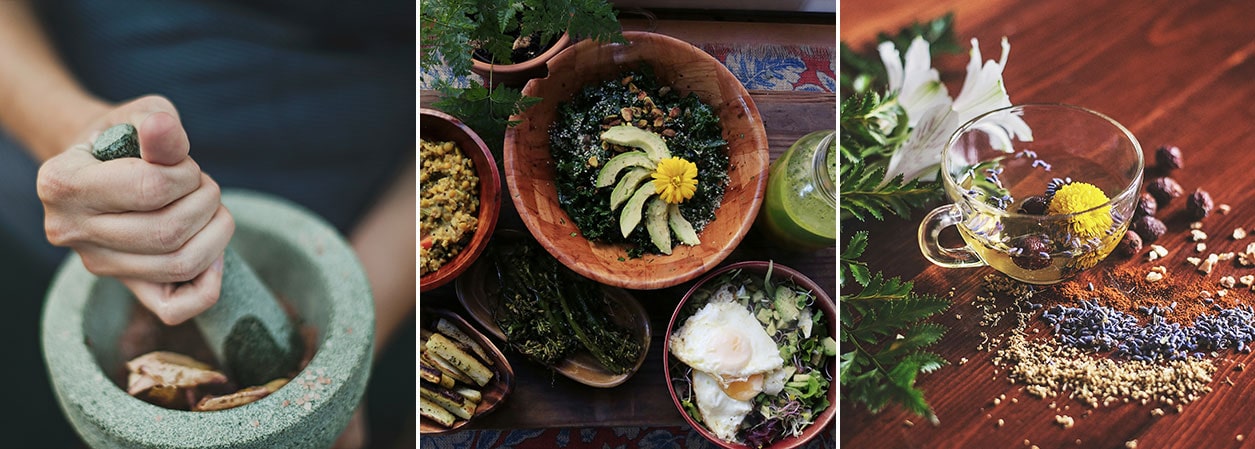
Unlock the Secrets of Ayurveda Cooking, Kochi
Embrace the ancient wisdom of Ayurveda in a culinary journey to health and well-being. Led by an experienced Ayurveda physician, this interactive session will guide you through the principles of Ayurveda cooking, helping you unlock the secrets to a healthier, happier you.

A Royal Feast for the Senses, Kochi
Indulge in a lavish vegetarian feast, the traditional Sadya, savouring the flavours and traditions of Kerala. Experience the warmth of a true Kerala celebration with each delicious bite. A feast for the senses, the Sadya is a must-try for any food lover visiting Kerala.
Write to your relationship manager for more details.
ITINERARY OF THE MONTH
Celebrating Onam in Kerala: A Festival of Harmony and Prosperity
Kochi – Thrissur – Kozhikode – Neeleshwaram – Mangalore
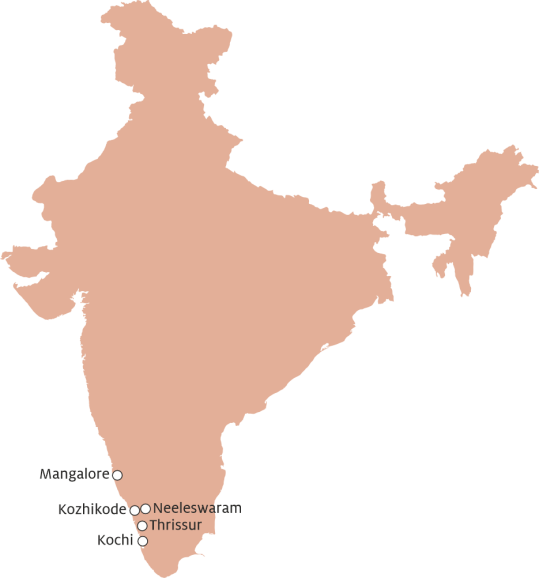
Highlights of the Tour

- Hear the story of Kathakali, a captivating classical dance-drama from the members of an all-women’s Kathakali troupe, who broke gender barriers and reshaped the Kathakali landscape.
- Enjoy a sumptuous vegetarian feast, the traditional Sadya, savouring the flavours and traditions of Kerala
- Stay at a boutique property on the outskirts of Thrissur, the ‘Cultural Capital of Kerala’ and participate in the Onam rituals and traditional flower decorations with locals
- Witness the rural art form of ‘Onam Kali’ involving singing and dancing by the villagers, which is a part of the Onam celebration across Kerala.
- Explore Kozhikode which has been a prominent centre for spice trade in Kerala for centuries.
- Stay 04 nights at Neeleshwar Heritage, a chic beach side property spending your time in the Ayurveda spa, walking along the palm-fringed beach, cycling through the paddy fields, practising yoga, learning to meditate or exploring the tranquil backwaters on their beautiful 2-bedroom houseboat (Houseboat to be pre-booked).
Write to your relationship manager for the detailed Onam itinerary.
Stories from India
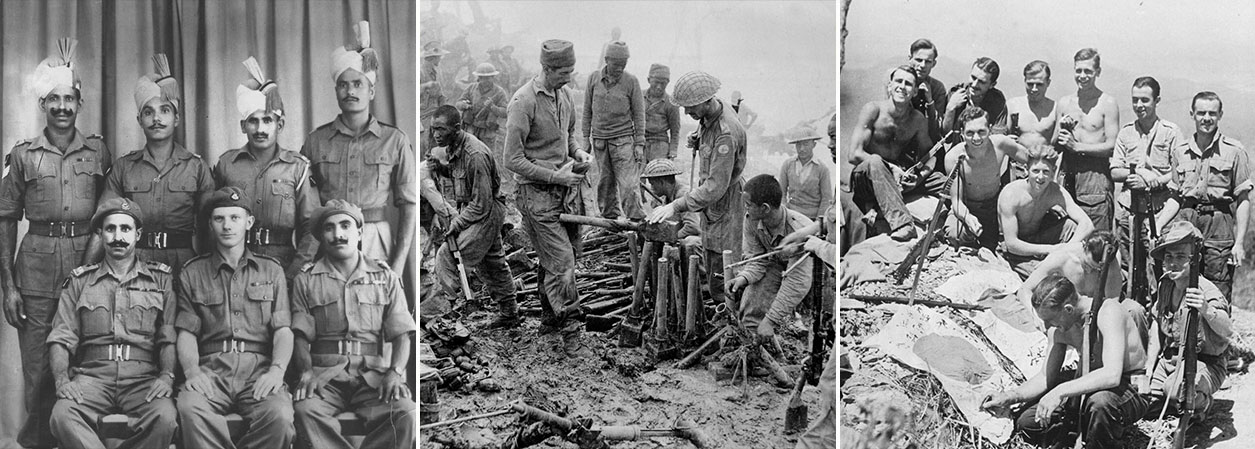
Britain’s Greatest Battle
From the Research Hub of the Destination Knowledge Centre
British military historian Robert Lyman describes the twin battles of Imphal and Kohima in Northeast India as one of the four great turning-points of World War 2
An epic clash took place in 1944 during the Second World War between the Allied Forces and the Japanese Imperial Army in North East India. Centred in and around Imphal and Kohima, now capital cities of the states of Manipur and Nagaland respectively, from March to July of that year, the twin battles involved some of the bitterest fighting in the Asian theatre.
Together with the Japanese Army also came a much smaller force of Netaji Subhash Chandra Bose’s Indian National Army (INA). Bose is a controversial yet celebrated freedom fighter of India who coined the famous slogan – “Give me blood and I will give you freedom”. He disagreed with Mahatma Gandhi and parted ways as he believed that freedom cannot be earned by non-violence. The INA formed the first provincial government of Independent India at Moirang, not too far away from Imphal on April 14, 1944. British military historian Robert Lyman describes the twin battles of Imphal and Kohima as one of the four great turning-points of the Second World War, with Stalingrad, El Alamein, and Midway being the other three. In April 2013, the UK’s National Army Museum named the Battles of Imphal and Kohima as ‘Britain’s Greatest Battle’ of all time.
The Japanese marched into Northeast India after taking over Burma (now Myanmar) through Manipur. Their strategy was to capture Kohima and then the town of Dimapur, the gateway to the hills of Kohima with an airfield and railway station, for further incursions into the plains of Assam. The Red Hill on the Tiddim Road and the Shenam Saddle, not too far away from the India-Myanmar border, saw fierce fighting between the Allied and the Japanese forces. Both these sites can be visited from Imphal on day trips. The only Japanese memorial of World War 2 in India is also located on the Tiddim Road. Inside the historic Kangla Fort, the erstwhile residence of the Manipuri Royals in Imphal one can also see the cottage of Field Marshal Sir William Slim. This is from where he oversaw the Burma Campaign for the Allied Forces.
Enroute Imphal –Kohima is the village of Kigwema. Here the spartan wooden cabin where General Kotoku Sato of the Japanese Imperial Army stayed during the entire siege of Kohima is still there in very good condition. Another historic site enroute Imphal – Kohima is Milestone 109 where Indian troops fighting for the British Commonwealth and British troops had linked up from Kohima and Imphal on June 22, 1944, ending the Japanese siege of Imphal.
In Kohima, the brutal battle between the Allied Forces and the Japanese Imperial Army was fought in the famous Kohima Ridge. Some of the old positions of the Allied Forces are Jail Hill, DIS, Kuki Piquet, and Garrison Hill. Although a largely built-up area today, a walk on the ridge allows one to get a feel of one of the most bitterly fought battles of the Burma Campaign. At the Kohima War Cemetery, one can still see the outline of the famous tennis court around which fierce fighting raged in 1944. The Kohima Cathedral which is not too far away was built with the contribution of the Japanese government to offer prayers in the memory of the fallen Japanese soldiers. It is heart-warming to know that the veterans of the Allied Forces and the Japanese Imperial Army of 1944 have forgiven each other and meet once in a while at the Kohima Cathedral to discuss peace.
50,000 soldiers died fighting in Imphal and Kohima. It was Japan’s biggest defeat and turned the tide of World War 2 in the Asian theatre. Lord Mountbatten, the last British Viceroy of India called it the British-Indian Thermopylae.
THE STORY OF BADLURAM AND THE AMERICAN CIVIL WAR CONNECTION
During the siege of Kohima, Rifleman Badluram, a young soldier from the Assam Regiment died from a gunshot wound. After Badluram’s death, the quartermaster CQMH (company quarter master havildar) Kandarpa Rajbongshi could not remove his name from the ration roster since all communications were cut off by the Japanese. The company continued to draw Badluram’s share of ration even after his death and this extra ration helped the company survive through the siege. Accordingly, a song – Badluram Ka Badan (Badluram’s Body)- was composed in Badluram’s honour with the lyrics “Badluram ke Badan Zameen Ke Niche Hein, Aur Haame Uska Ration Milta Hein”(We get rations because Badluram’s body is buried beneath the ground) and set to the tune of “John Brown’s Body”- a popular song in the Union during the American Civil War. John Brown was a radical abolitionist from Kansas who rejected the pacifist and believed that violence was the only way to end slavery in America. He was executed in 1859 for a failed attempt to entice a slave rebellion. Badluram Ka Badan is now the regimental song of the Assam Regiment of the Indian Army.
“The War 2 sites of Kohima and Imphal can be visited with an expert as a part of a special interest tour. They can also be included in the sightseeing of Kohima and Imphal. The World War 2 museum of Hornbill Festival (01-10 December, every year) also provides a fascinating insight into one of Britain’s greatest battle in the Asian theatre” (Kuntil Baruwa, Explorer, Destination Knowledge Centre)
Write to your relationship manager for more details and a detailed itinerary of Kohima and Imphal.
Sustainability and Us

Sustainable Business Travel
By Dipak Deva, Managing Director, Travel Corporation India Ltd
As business leaders, we have a responsibility to minimise the environmental impact of our business travel.
Here are 10 actionable steps to make your next business trip greener:
- Conscious Flight Choices: Opt for airlines with strong sustainability initiatives, consider carbon offsetting, and choose direct flights whenever possible to reduce emissions.
- Eco-Friendly Accommodations: Select hotels with certifications like LEED or Green Key, prioritising those with energy-efficient practices and waste reduction programs.
- Pack Sustainably: Minimise luggage by packing light and choosing reusable toiletries to reduce waste.
- Sustainable Transportation: Prioritise public transport, walking, or cycling for local travel. When necessary, choose hybrid or electric vehicles for rentals.
- Digital Documentation: Opt for electronic documents and presentations to reduce paper consumption.
- Waste Reduction: Minimise single-use plastics, bring reusable water bottles, and properly dispose of waste.
- Local Cuisine: Enjoy the local cuisine by dining at authentic restaurants. This benefits the local economy and reduces the carbon footprint associated with food transportation.
- Local Craftsmanship: Discover unique souvenirs and support the community by purchasing directly from local artisans. This helps to preserve traditional skills.
- Local Sightseeing: Partner with local businesses offering immersive tours and activities that showcase the destination’s history, culture and traditions responsibly.
- Knowledge Sharing: Share your sustainable travel experiences to inspire colleagues and clients to adopt eco-friendly practices.
By incorporating these practices into your business travel, you can contribute to a healthier planet while demonstrating leadership in sustainability.
Explore
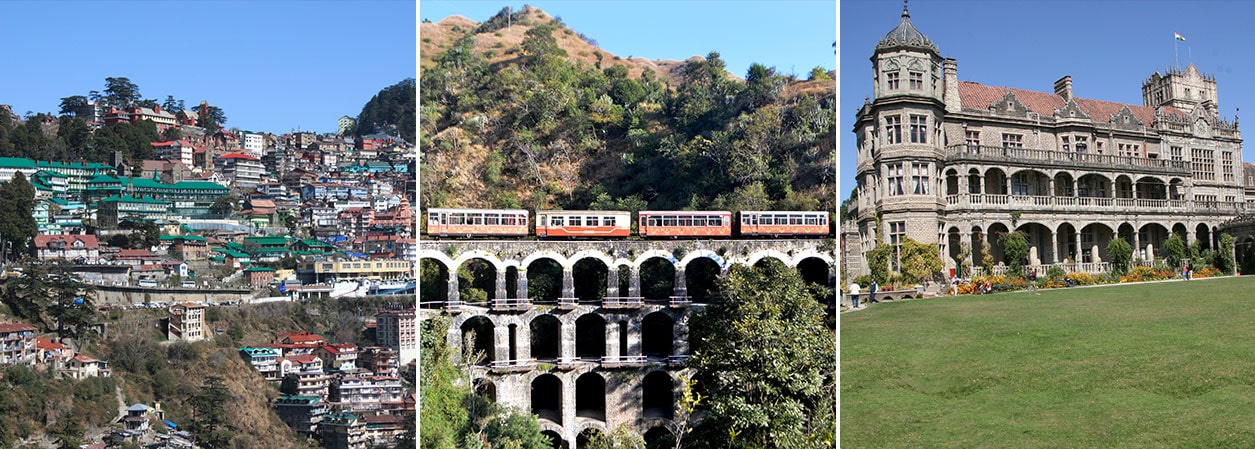
Shimla – The Queen of Hills
From the Travel Diary of Inderjeet Rathod, Product Manager, Destination Knowledge Centre
Perched amidst the majestic Himalayas, Shimla, the former summer capital of British India (1864-1947), exudes an undeniable charm. Often referred to as the ‘Queen of Hills’, this picturesque hill station is renowned for its colonial architecture, verdant landscapes, and crisp, invigorating air. Nestled at an altitude of approximately 2,200 metres, Shimla offers a welcome respite from the sweltering plains. With its captivating blend of British heritage and Indian culture, this enchanting destination continues to be a favoured retreat for travellers seeking tranquillity, adventure, or simply a romantic escape.
Best time to visit
Shimla is a good destination for both summer (April – June) and winter (October – February).
Summer in Shimla offers clear blue skies, invigorating air, and the delightful scent of pine, fir, cedar, and oak. Lasting from April to June, the pleasant weather, with temperatures between 17°C and 25°C, makes it perfect for hiking, and picnics.
Winter in Shimla is beautiful. Temperatures plummet to near freezing, creating a cosy atmosphere perfect for curling up with a warm drink and enjoying the stunning views. From October to February, the town transforms, offering a magical escape. Christmas and New Year celebrations are particularly enchanting, often graced with fresh snowfall. Visitors can enjoy leisurely strolls along the snow-covered Ridge.
My Personal Favourites in and around Shimla:
- The Town Hall: A Tudor Masterpiece: A striking example of Tudor architecture, the Town Hall once dominated the Shimla skyline. Inspired by traditional English country houses, this imposing building features a sloping roof, herringbone brickwork, half-timbered structure, and picturesque pillared porches. The work of renowned architect Henry Erwin, the Town Hall initially housed the Gaiety Theatre, the social hub of British Shimla. Within its grand walls, a library, a ballroom, and even an armoury coexisted, reflecting the building’s multifaceted role. Today, it serves as the headquarters of the Shimla Municipal Corporation.
- Gaiety Theatre: The Mecca of English Theatre: Shimla earned the title of the ‘Mecca of English Theatre’, and the Gaiety Theatre on Mall Road was its beating heart. Designed by the acclaimed architect Henry Irwin, this Norman Gothic building was once part of the towering Town Hall. Modelled after London’s Royal Albert Hall, the Gaiety Theatre stands as a unique gem in India, housing an extraordinary collection of over 400 scripts. Among these are 108 original plays performed during the British Raj, a testament to the theatre’s rich history. Today, any theatre group can access this treasure trove to bring these classic plays back to life.
- Chapslee: A Historic Shimla Residence: Chapslee stands as one of Shimla’s oldest houses, steeped in history. Originally built in 1830 by Dr. Blake of the East India Company, it later served as Lord Auckland’s Secretariat. In 1848, General Innes acquired the property and named it Chapslee. Sir Arthur Milford Ker purchased the house in 1896, expanding it while preserving the original structure. Recognised as Shimla’s finest residence in 1904, Chapslee eventually became the property of the King of Kapurthala of Punjab. Today, it operates as a heritage hotel, offering a glimpse into Shimla’s illustrious past.
- The Railway Board Building: A Masterpiece of Engineering: The Railway Board Building is a distinctive architectural marvel in Shimla. Constructed with fire-resistant cast iron and steel, this four-storey edifice features impressive iron staircases. Its unique design has served as a model for subsequent government buildings in the region, including the Himachal Pradesh Secretariat and the Army Training Command. Every component of the building was shipped from the UK and undertook an arduous journey to Shimla, transported by bullock carts, horses, and even elephants. This remarkable structure continues to inspire students of architecture and engineering, showcasing its enduring influence.
- The Indian Institute of Advanced Study: A Legacy of Power and Learning: Formerly the Viceregal Lodge, the seat of British power in India during the summer, the Indian Institute of Advanced Study (IIAS) stands as a remarkable insight to the region’s history. Established in the mid-1960s, this research institute also serves as the summer retreat of the Indian President now. Designed by the renowned architect Henry Erwin in the Gothic style, the IIAS is a magnificent structure set amidst 331 acres of beautifully landscaped gardens. A pioneer in its time, the building was the first in Shimla to be electrified and featured an advanced rainwater collection system. Within its walls, pivotal decisions, including the partition of India, were made.I often find myself wishing that more of this extraordinary place could be opened to the public. This is a global heritage site, and the idea of sharing it more widely should be deeply thought of.
- Toy Train ride from Shimla to Kandaghat: A Marvel of Engineering: A UNESCO World Heritage Site, the Kalka-Shimla Railway is a remarkable feat of colonial engineering. Before the iron horse chugged its way up the hills, reaching Shimla was an epic arduous journey. The British entourage from Calcutta and elsewhere had to endure a bone-shaking journey by any means possible – from sturdy carts pulled by oxen to horseback rides, and in some cases, even the unlikely mode of transport: elephants! The old trail is now lost to modern roads, though remnants remain, including a hotel built for travellers enroute, now the home of a village leader. Constructed over five years, this engineering marvel involved building 107 tunnels and 864 bridges. Each of these structures holds its own fascinating history. The train journey offers a unique perspective on the region’s beauty and history.
- The Sanat Art Foundation: A Haven for Art Lovers: Situated amidst the serene pine and cedar forests of Shimla, the Sanat Art Foundation is a sanctuary for art enthusiasts. Home to a remarkable collection of Indian art, the foundation is particularly renowned for its possession of rare paintings and personal belongings of Rabindranath Tagore. The gallery houses a diverse array of works by prominent artists, including those from the Bengal School of Art. Sanat Chatterjee, the foundation’s namesake, is represented by a comprehensive collection of his art, including his record-breaking silk and paper paintings. A hidden gem and a must visit for Artists and Art enthusiasts alike.
- A Stroll Through Time: The Sleeping Beauty Trail: The Sleeping Beauty Trail offers a unique opportunity to explore Elysium Hill, a tranquil oasis just a short distance from the bustling Mall Road. This walking trail provides a fascinating glimpse into Shimla’s evolution. As you wander along, you will pass the Lakkar Bazaar, the former residence of the Chief Engineer of the Kalka-Shimla Railway, and Auckland School, once home to Alexander Malcom Jacob, renowned for his association with the Jacob Diamond. Chapslee, built in 1838 as a lodge for the British Governor General’s secretary, is another notable landmark on the trail. Along the way, admire the beautiful blossoms and pause to learn about Sterling Castle, one of Shimla’s first three houses, constructed in 1833.
- A Day in Dhami: Nature, History, and Gastronomy: A day trip to Dhami, a former hunting ground for British Viceroys during the summer, offers a delightful escape into nature. Located a short forty-five-minute drive from Shimla, Dhami is a haven for birdwatchers and nature enthusiasts. The highlight of the trip is undoubtedly the company of Kunwar Dushyant Singh, a descendant of the Dhami royal family and a pioneering figure in wildlife tourism at Bandavgarh National Park. His profound knowledge of birds, local flora, fauna, and the region’s history enriches the experience. After a morning of exploration, guests are treated to a delicious home-cooked lunch prepared by his wife, a member of the Tikamgarh royal family, not too far away from the temple town of Khajuraho. The afternoon unfolds with a leisurely nature walk guided by Kunwar Dushyant Singh before the return journey to Shimla.
Hotels in Shimla:
A Range of Accommodations for Every Traveller:
Shimla offers a diverse selection of accommodation options to cater to all preferences and budgets. From budget-friendly hotels to opulent luxury retreats, there is something to suit every traveller. Guests can choose from a variety of neighbourhoods, each offering its own unique charm and atmosphere.
Some of the well-known Hotels and Resorts in Shimla are:
- Taj Theog Resort & Spa Shimla (Five Star)
- The Oberoi Cecil (Five Star)
- Elysium Resort & Spa (Four Star)
- Hotel Willow Banks (Four Star)
- The Orchid Shimla (Four Star)
- Radisson Jass (Four Star)
- Larisa Hotels & Resorts, Shimla (Four Star)
- Chapslee (Heritage boutique hotel)
- Clarkes Oberoi (Heritage boutique)
- Jungle House (Heritage boutique)
- amã Stays & Trails Ballyhack Cottage (Heritage boutique- one key)
- Woodville Palace (Heritage boutique hotel)
- Shimla Havens Hotels and Resorts (Mid-Range)
- Snow Valley Resort (Mid-Range)
- Toshali Royal View Resort (Mid-Range)
- The Zion (Mid-Range)
- The Grand White (Mid-Range)
- Fairmount Shimla (Mid-Range))
- Club Mahindra Shimla (Mid-Range)
- Golden Fern Resorts (Mid-Range)
- De Exotica Crest (Mid-Range)
- Hotel Baljees Regency (Mid-Range)
- Hotel Sangeet (Mid-Range)
- Rahat Regency (Mid-Range)
Accessibility
Road:
- Delhi, the capital city of the country lies at a distance of 345 km from Shimla.
- Amritsar, the high seat of the Sikh Religion is located at a distance of 322 km from Shimla.
- Dharamshala, the home of the Dalai Lama and the capital of the Tibetan government in exile is located at a distance of 230 km from Shimla.
- Pragpur, the home of theSood merchants, whose entrepreneurial spirit and trading acumen left an indelible mark on the region, is located at a distance of 192 km from Shimla.
- Chandigarh, designed by the renowned Swiss-French architect Le Corbusier is located 110 km from Shimla.
Train:
Shimla is connected to Kalka in the state of Haryana by a 120 year old narrow-gauge railway line which runs for 94 km through 102 tunnels. Kalka has both a narrow gauge as well as a broad-gauge Railway stations. Direct trains ply from Kalka to Delhi, and Howrah (in West Bengal). Both Delhi and Calcutta, now Kolkata, the capital city of the state of West Bengal, have served as capitals of the British Raj.
Weaving it into an itinerary:
Delhi –Amritsar- Dharamshala – Pragpur – Shimla – Chandigarh – Delhi
Write to your relationship manager for more details on Shimla and the Itinerary
Inspiration

Sikkim: Requiem for a Himalayan Kingdom by Andrew Duff
Book Review by Bene Eapen
Title of the Book: Sikkim: Requiem for a Himalayan Kingdom
Name of the Author: Andrew Duff
Central Idea of the Book: This true story chronicles the rise and fall of Sikkim, a once independent Buddhist kingdom nestled in the Himalayas. The book follows the extraordinary journey of Palden Thondup Namgyal, Sikkim’s last Chogyal (King), and his American wife, Hope Cooke. Their fairy-tale romance is set against the backdrop of a kingdom fighting to preserve its sovereignty. As the Cold War cast a long shadow over the region, Sikkim found itself caught in a geopolitical struggle. Ultimately, the kingdom became part of India in 1975, marking the end of an era and the beginning of a new chapter for its people.
My View: Sikkim: Requiem for a Himalayan Kingdom is a poignant elegy for a lost world. Andrew Duff’s masterful narrative intertwines the fairy-tale romance of Thondup and Hope Cooke with the stark realities of geopolitics, painting a vivid portrait of a kingdom on the precipice. The book is a nuanced exploration of power, identity, and the tragic consequences of geopolitical manoeuvring. Duff’s meticulous research transforms this tale into a compelling examination of Sikkim’s history, challenging our understanding of the region’s complexities. Beyond a mere love story, it’s a sobering reminder of the fragility of sovereignty and the human cost of political ambition.
My Rating: Must Read
Festival to Watch Out For
Onam – Kerala
6 – 15 September, 2024
From the Festival Calendar of the Destination Knowledge Centre

PC – Ashik Jayaram
Onam, Kerala’s most vibrant festival, is a ten-day extravaganza marking the harvest season. Similar to Thanksgiving in North America or the Mid-Autumn Festival in East Asia, it’s a time for gratitude, family reunions, and bountiful feasts. The festival is characterized by elaborate floral carpets, traditional boat races, parades and cultural performances.
Write to your relationship manager for our Onam Festival Itinerary and a Copy of our Festival Calendar (2024-25)
RESOURCES
SITE LINKS
CONTACT US
+ 91 (124) 4563000
Tower B, Delta Square, M.G. Road, Sector 25, Gurgaon - 122001, Haryana, National Capital Region of Delhi, India










